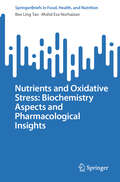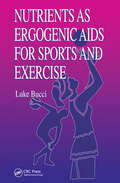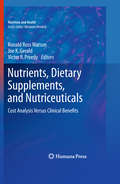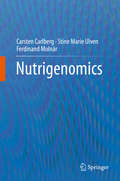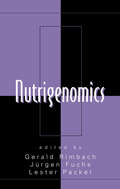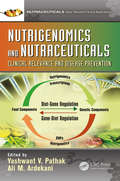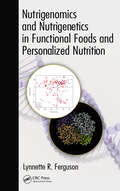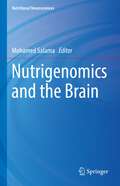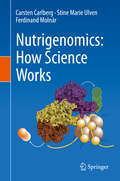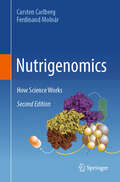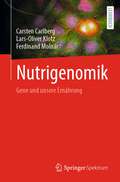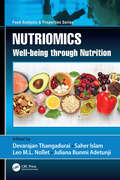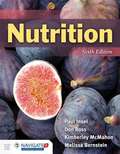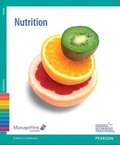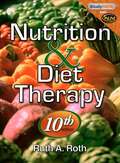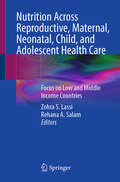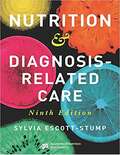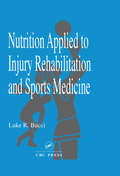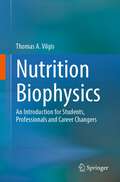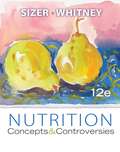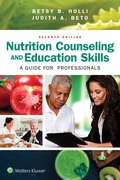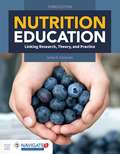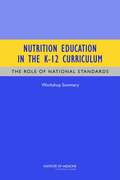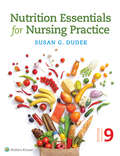- Table View
- List View
Nutrients and Oxidative Stress: Biochemistry Aspects and Pharmacological Insights (SpringerBriefs in Food, Health, and Nutrition)
by Bee Ling Tan Mohd Esa NorhaizanOxidative stress plays a prominent role in the development of numerous human diseases associated with animal-based protein, high-carbohydrate diets and excessive fat consumption. Obesity represents the main risk factor for chronic diseases such as cardiovascular disease, cancer, and type 2 diabetes. Extensive research highlights the detrimental impacts of diets high in saturated fat and refined carbohydrates. Type 2 diabetes, cardiovascular disease and obesity are attributed to the sedentary lifestyles, overconsumption of foods high in saturated fats and carbohydrates, and the saturation of nutrient storage. Indeed, the effects of oxidative stress are associated with the absolute quantity and the type of macronutrients; both of these aspects contribute to oxidative stress and may favor the development of obesity-associated diseases and obesity. Nonetheless, the underlying mechanisms of nutritionally mediated oxidative stress are complex and poorly understood. The literature reported on nutritionally mediated oxidative stress and the role of diets in oxidative stress-induced diseases has not well been compiled in a singular source. “Nutrients and Oxidative Stress: Biochemistry Aspects and Pharmacological Insights” explores how dietary choices dampen or exacerbate inflammation and oxidative stress. The implications of oxidative stress in glucose metabolism and adipocyte and obesity-associated non-communicable diseases are also discussed in this brief. Several issues linked to nutritionally mediated oxidative stress, including high carbohydrates, high animal-based proteins, and excessive consumption of fats and oxidative stress, and molecular mechanisms of oxidative stress-induced diseases are covered. The role of diets in oxidative stress-induced diseases is also discussed. By summarizing all the literature in one place, this work provides a cohesive representation of the information and practical reference on the underlying mechanisms of nutritionally mediated oxidative stress involved in the prevention of chronic diseases. The work provides a better understanding of the nutritionally mediated oxidative stress and the molecular mechanisms of oxidative stress in the development of chronic diseases and obesity.
Nutrients as Ergogenic Aids for Sports and Exercise (Nutrition In Exercise And Sport Ser. #2)
by Luke R. BucciNutrients as Ergogenic Aids for Sports and Exercise discusses the growing body of information regarding the enhancement of human physical performance by dietary manipulations through ergogenesis. It balances the application of nutritional manipulations between overzealous promoters and recalcitrant cynics. By offering a thorough, comprehensive and up-to-date review of what is known about ergogenic effects of nutrients on humans, it bridges the gap between common usage and scientific knowledge. Nutrients as Ergogenic Aids for Sports and Exercise covers in detail many popular product ingredients not considered elsewhere. It illustrates areas awaiting future research, and offers suggestions for avoiding the pitfalls of performing ergogenesis research.
Nutrients, Dietary Supplements, and Nutriceuticals
by Victor R. Preedy Ronald Ross Watson Joe K GeraldNutrients, Dietary Supplements, and Nutriceuticals: Cost Analysis Versus Clinical Benefits provides the most current, concise, scientific appraisal and economic analysis (costs vs. benefit) of nutritional supplements and bioactive components (nutriceuticals) of foods in improving the quality of life. It fills a much-needed gap to have a single volume provide a synopsis of cost analysis of dietary supplements and nutritional products as well as therapies for treatment and prevention of disease. Chapters include emerging fields of science and important discoveries relating to early stages of new nutriceuticals in cancer prevention, prior to clinical trials. Written by international and national standing leaders in the field, Nutrients, Dietary Supplements, and Nutriceuticals: Cost Analysis Versus Clinical Benefits is essential reading for nutritionists, pharmacologists, health care professionals, research scientists, cancer workers, pathologists, molecular and cellular biochemists, physicians, general practitioners as well as those interested in diet and nutrition in disease resistance via immune regulation.
Nutrigenomics
by Carsten Carlberg Ferdinand Molnár Stine Marie UlvenThe fascinating area of Nutrigenomics describes this daily communication between diet, food and nutrients, their metabolites and our genome. This book describes how nutrition shapes human evolution and demonstrates its consequences for our susceptibility to diseases, such as diabetes and atherosclerosis. Inappropriate diet can yield stress for our cells, tissues and organs and then it is often associated with low-grade chronic inflammation. Overnutrition paired with physical inactivity leads to overweight and obesity and results in increased burden for a body that originally was adapted for a life in the savannas of East Africa. Therefore, this textbook does not discuss a theoretical topic in science, but it talks about real life, and our life-long "chat" with diet. We are all food consumers, thus each of us is concerned by the topic of this book and should be aware of its mechanisms. The purpose of this book is to provide an overview on the principles of nutrigenomics and their relation to health or disease. We are not aiming to compete with more comprehensive textbooks on molecular nutrition, evolutionary biology, genomics, gene regulation or metabolic diseases, but rather will focus on the essentials and will combine, in a compact form, elements from different disciplines. In order to facilitate the latter, we favor a high figure-to-text ratio following the rule "a picture tells more than thousand words". The content of this book is based on the lecture course "Nutrigenomics", which is held since 2003 once per year by Prof. Carlberg at the University of Eastern Finland in Kuopio. The book is subdivided into three sections and twelve chapters. Following the "Introduction" there are sections on the "Molecular genetic basis" and the "Links to disease", which take a view on nutrigenomics from the perspective of molecular mechanisms or from the causes of metabolic diseases, respectively. Besides its value as a textbook, Nutrigenomics will be a usefull reference for individuals working in biomedicine.
Nutrigenomics (Oxidative Stress and Disease)
by Martin GardnerNutritional genomics, also referred to as nutrigenomics, is considered one of the next frontiers in the post-genomic era. This book features the latest research on the role of oxidants and dietary antioxidants in the modulation of gene expression, aging, immune function, neuroprotection, and vascular heath. It covers the relationship between oxidants, antioxidants, and gene expression, as well as new molecular techniques for the study of redox-regulated signal transduction. It summarizes the molecular mechanisms of phytochemicals and trace elements, emphasizes the impact of variations in the human genotype on individual responses to nutrients, and offers a summary of the effect of lipid and water soluble antioxidants and fatty acids on gene expression in cultured cells, laboratory animals, and humans.
Nutrigenomics and Nutraceuticals: Clinical Relevance and Disease Prevention (Nutraceuticals)
by Yashwant V. Pathak Ali M. ArdekaniGenomics and related areas of research have contributed greatly to the understanding of the cellular and molecular mechanisms underlying diet–disease relationships. In the past decade, the evidence has become stronger for a direct link between genome/epigenome damage and increased risk for adverse health outcomes. It is now exceedingly clear that micronutrients are critical as cofactors for many cellular functions, including DNA repair enzymes, methylation of CpG sequences, DNA oxidation, and/or uracil incorporation into DNA. Nutrigenomics and Nutraceuticals: Clinical Relevance and Disease Prevention brings new perspectives on disease prevention strategy based on the genomic knowledge and nutraceuticals of an individual and the diet he or she receives. This book discusses the integration and application of genetic and genomics technology into nutrition research and paves the way for the development of nutrition research programs that are aimed at the prevention and control of chronic disease through genomics-based nutritional interventions. In this book, the editors bring together a wide spectrum of nutritional scientists worldwide to contribute to the growing knowledge in the field of nutrigenomics and nutraceuticals.
Nutrigenomics and Nutrigenetics in Functional Foods and Personalized Nutrition
by Lynnette R. FergusonWhile functional foods have become a reasonably well-established concept, personalized nutrition is still treated with skepticism by many. The recognition that people would have different nutrient requirements, or perceive foods in different ways, raises several concerns-some real, some not so real. Nutrigenomics and Nutrigenetics in Functional Foo
Nutrigenomics and the Brain (Nutritional Neurosciences)
by Mohamed SalamaDr. Mohammed Salama is Atlantic senior fellow for Equity in brain health at the Global Brain Health Institute (GBHI) and Associate professor at the Institute of Global Health and Human Ecology at the American University in Cairo (AUC). He established the first Translational Neuroscience Unit in Egypt. Mohamed’s collaborative research led to establishing the Egyptian Network for Neurodegenerative Disorders Mohamed was selected as a SOT Global Senior Scholar in 2013 and Translational/bridging awardee in 2016. He was awarded by Parkinson’s and Movement Disorders Foundation (PMDF) for his continued research in neurodegeneration. Recently, Mohamed and his colleagues succeeded in drafting the first Reference Egyptian Genome and collaborating with other colleagues to start a national cohort (A Longitudinal Study of Egyptian Health Aging [AL-SEHA]).
Nutrigenomics: How Science Works
by Carsten Carlberg Ferdinand Molnár Stine Marie UlvenThe fascinating area of Nutrigenomics describes this daily communication between our diet and our genome. This book describes how nutrition shapes human evolution and demonstrates its consequences for our susceptibility to diseases, such as diabetes and atherosclerosis. Inappropriate diet can yield stress for our cells, tissues and organs and then it is often associated with low-grade chronic inflammation. Overnutrition paired with physical inactivity leads to overweight and obesity and results in increased burden for a body that originally was adapted for a life in the savannahs of East Africa. Therefore, this textbook does not discuss a theoretical topic in science, but it talks about real life and our life-long “chat” with diet. We are all food consumers, thus each of us is concerned by the topic of this book and should be aware of its mechanisms.The purpose of this book is to provide an overview on the principles of nutrigenomics and their relation to health or disease. The content of this book is based on the lecture course “Nutrigenomics”, which is held since 2003 once per year by Prof. Carlberg at the University of Eastern Finland in Kuopio. The book represents an updated but simplified version of our textbook “Nutrigenomics” (ISBN 978-3-319-30413-7). Besides its value as a textbook, “Nutrigenomics: how science works” will be a useful reference for individuals working in biomedicine
Nutrigenomics: How Science Works
by Carsten Carlberg Ferdinand MolnárNow in its second edition, this concise textbook provides an overview of the field of nutrigenomics, a topic at the intersection of nutrition and genetics that explores how dietary molecules interact with our genome and epigenome to influence health and disease. Substantially updated and expanded, the book offers a fresh perspective on how diet has shaped human evolution and our susceptibility to conditions such as type 2 diabetes and cardiovascular disease. The 11 chapters cover a wide range of topics, beginning with an overview of the role of nutrients in health and disease, basic mechanisms of nutrient sensing and nuclear receptors, and the impact of epigenetic regulation on health. Readers will discover how chromatin-modifying enzymes and energy status-sensing kinases play critical roles in signaling pathways between diet and the genome. The book also explores the influence of diet on cancer prevention, the importance of the microbiome, and low-grade chronic inflammation and aging. Written in an accessible style, this textbook is intended for undergraduate and graduate students in nutrition, biochemistry, molecular biology, and biology as well as for students and practitioners in medicine. Numerous color illustrations aid in the transfer of knowledge by graphically summarizing complex processes. Combined with a glossary that explains key terms, this work is an indispensable resource for anyone interested in how our daily dietary choices interact with our genome.
Nutrigenomik: Gene und unsere Ernährung
by Lars-Oliver Klotz Carsten Carlberg Ferdinand MolnárWarum verstoffwechseln wir dieselben Mahlzeiten so unterschiedlich? Haben ernährungsbedingte Erkrankungen eine genetische Ursache? Können Genuntersuchungen Vorhersagen zum Eintreten solcher Erkrankungen liefern? Welchen Einfluss haben Umwelt und Verhalten? Mit diesen und ähnlichen Fragen befasst sich das Gebiet der Nutrigenomik, das die Wechselwirkung zwischen Ernährung und Genom erforscht. Zu Beginn dieses Lehrbuchs wird ein Überblick über die Bedeutung der Nutrigenomik im Kontext der Ernährungswissenschaften gegeben. Sodann wird auf das menschliche Genom sowie seine Variationen eingegangen und der besondere Einfluss der Ernährung auf dessen Evolution beschrieben. Im Anschluss werden die molekularen Grundlagen der Wechselwirkung von Nährstoffen und anderen Nahrungsbestandteilen mit zellulären Signalnetzwerken besprochen, die die Genexpression modulieren. In drei abschließenden Kapiteln werden nutrigenomische Aspekte von Erkrankungen wie Adipositas, Diabetes und Herz-Kreislauf-Erkrankungen besprochen. Dieses Lehrbuch richtet sich an Studierende der Ernährungswissenschaften, der Biochemie und Molekularbiologie sowie der Biologie. Zahlreiche Farbabbildungen unterstützen die Wissensvermittlung, indem komplexe Abläufe grafisch zusammengefasst werden. Verbunden mit einem Glossar, das die wichtigsten Fachbegriffe erklärt, eignet sich das Werk somit ideal zur Modulbegleitung und Prüfungsvorbereitung.
Nutriomics: Well-being through Nutrition (ISSN)
by Leo M.L. Nollet Devarajan Thangadurai Saher Islam Juliana Bunmi AdetunjiImplementation of robust omics technologies enables integrative and holistic interrogation related to nutrition by labeling biomarkers to empirically assess the dietary intake. Nutriomics: Well-being through Nutrition aims to enhance scientific evidence based on omics technologies and effectiveness of nutrition guidelines to promote well-being. It provides deep understanding towards nutrients and genotype effects on disease and health status. It also unveils the nutrient–health relation at the population and individual scale. This book helps to design the precise nutritional recommendations for prevention or treatment of nutrition-related syndromes.Nutriomics: Well-being through Nutrition focuses on: The impact of molecular approaches to revolutionize nutrition research for human well-being Various biomarkers for bioactive ingredient analysis in nutritional intervention research Potential of transcriptomic, genomic, proteomic, metabolomic, and epigenomic tools for nutrition care practices Recent updates on applications of omics technologies towards personalized nutrition Providing comprehensive reviews about omics technologies in nutritional science, Nutriomics: Well-being through Nutrition serves as an advanced source of reference for food developers, nutritionists, and dietary researchers to investigate and evaluate nutriomics tools for development of customized nutrition and food safety. It is also a useful source for clinicians and food industry officials who require intense knowledge about emerging dietary-related tools to revolutionize the nutrition industry.This is a volume in the Food Analysis and Properties series, a series designed to provide state-of-art coverage on topics to the understanding of physical, chemical, and functional properties of foods.
Nutrition
by Paul Insel Don Ross Melissa Bernstein Kimberley McMahonThe Sixth Edition of Nutrition provides a modern, comprehensive introduction to nutrition concepts, guidelines, and functions. Its student-focused approach provides readers with the knowledge they need to make informed decisions about their overall nutrition.
Nutrition
by National Restaurant Association StaffThis text focuses on NUTRITION topics. It includes essential content plus learning activities, case studies, professional profiles, research topics and more that support course objectives. The text and exam are part of the ManageFirst Program® from the National Restaurant Association (NRA). This edition is created to teach restaurant and hospitality students the core competencies of the Ten Pillars of Restaurant Management. The Ten Pillars of Restaurant Management is a job task analysis created with the input and validation of the industry that clearly indicates what a restaurant management professional must know in order to effectively and efficiently run a safe and profitable operation. The ManageFirst Program training program is based on a set of competencies defined by the restaurant, hospitality and foodservice industry as those needed for success. This competency-based program features 10 topics each with a textbook, online exam prep for students, instructor resources, a certification exam, certificate, and credential. The online exam prep for students is available with each textbook and includes helpful learning modules on test-taking strategies, practice tests for every chapter, a comprehensive cumulative practice test, and more! This textbook includes an exam answer sheet to be used with the paper-and-pencil version of the ManageFirst certification exam.
Nutrition & Diet Therapy
by Ruth A. RothNUTRITION & DIET THERAPY, 10TH EDITION is the ideal introduction to the essentials of nutrition concepts, good health and client care. This book will help nurses to more effectively help their clients improve their nutrition and overall health.
Nutrition Across Reproductive, Maternal, Neonatal, Child, and Adolescent Health Care: Focus on Low and Middle Income Countries
by Zohra S. Lassi Rehana A. SalamThis book, led by experienced academic nurses and epidemiologists, involves an overview of the global nutrition epidemiology, risk factors, effective health and non-health sector interventions, success stories, insights, and work of nurse and allied health experts of the field, stressing on nutrition as one of the top priorities for women and children living in low and middle income countries (LMICs) specially in disadvantaged and underserved areas. The book focuses on nutritional epidemiology and transition in LMICs, and interventions to improve nutrition across the continuum of care for equitable access at each stage: reproductive, maternal, neonatal, child, and adolescent health (RMNCAH) care. It also discusses the consequences of hidden hunger, climate change, and conflict on nutritional status of women and children and how best to integrate potentially effective cross-cutting strategies to counter these emerging challenges. It will appeal to nurses, academics and public health practitioners, but is also of interest to development partners, NGOs, Multilateral agencies and nutrition program implementers.
Nutrition And Diagnosis-related Care
by Sylvia Escott-StumpThis authoritative go-to resource for students and clinical nutrition practitioners covers over 270 conditions in 16 sections. Each section provides an overview followed by essential evidence-based information on nutrition management of each condition. Nutrition therapy and practical guidance is presented in a unique style that is easy-to-navigate and implement in practice. Mini case studies throughout demonstrate application of the Nutrition Care Process and standardized language in a practical example.
Nutrition And Diet Therapy
by Linda Kelly Debruyne Eleanor Noss Whitney Kathryn PinnaNUTRITION AND DIET THERAPY, 9th Edition, is unique in its organization by diets rather than by organ systems or disease states and distinguishes itself through rich pedagogical features that require students to apply their knowledge as they learn it. This text provides core nutrition concepts and up-to-date clinical content at a level that is accessible to the range of health care team members who are responsible for a client's nutrition needs. NUTRITION AND DIET THERAPY provides the basic facts and a wealth of practical information readers need to assume their responsibility for nutrition care.
Nutrition Applied to Injury Rehabilitation and Sports Medicine (Nutrition In Exercise And Sport Ser. #4)
by Luke R. BucciThis timely and exciting new book brings together for the first time the readily available choices of dietary supplements and their relationship to injury rehabilitation. Nutrition Applied to Injury Rehabilitation and Sports Medicine supports the rational use of specific nutrients for specific healing conditions. Guidelines for nutritional programs applied to specific conditions are provided for practical application.
Nutrition Biophysics: An Introduction for Students, Professionals and Career Changers
by Thomas A. VilgisDo you no longer understand the countless, contradictory dietary recommendations? Do you find it difficult to distinguish between good and bad when it comes to cholesterol? Are you torn between the various dietary rules and nutritional forms that come your way every day and despair of the term "healthy diet"? Or are you confronted professionally, e.g. as a consultant or fitness coach, with questions on the subject of nutrition and would like to learn the scientific basics? The author Thomas Vilgis advises you to remain calm and to think objectively about all assumptions, presumptions, promises and suggestions for orientation.This book leads you off the beaten track and with a scientific, sober view to fundamental questions of nutrition. Starting with the nutritional history of Homo sapiens, the author guides you into the fundamental interplay between proteins, fats, and carbohydrates, what they do in the body, how they are digested, and what role they really play. Supporting you will find in the second edition various retrievable videos in which complex relationships are clearly explained. This quickly shows how little is hidden behind some dubious statements. With the claim of a scientific and molecular view of nutrition, it is possible to put into perspective and classify many a questionable recommendation on nutrition in an understandable and entertaining way.
Nutrition Concepts and Controversies (12th edition)
by Frances Sienkiewicz Sizer Ellie WhitneyThis book provides practical applications and accessible explanations to dispel common misconceptions about nutrition and empowers readers to make informed, healthier decisions.
Nutrition Counseling And Education Skills: A Guide For Professionals
by Judith Beto Betsy HolliNow in vibrant full color, this updated Seventh Edition of Holli’s best-selling Nutrition Counseling and Education Skills: A Guide for Professionals helps students develop the communications, counseling, interviewing, motivational, and professional skills they’ll need as Registered Dietitian professionals. Throughout the book, the authors focus on effective nutrition interventions, evidence-based theories and models, clinical nutrition principles, and knowledge of behavioral science and educational approaches. Packed with activities, case studies, and self-assessment questions, the Seventh Edition features new content that reflects the latest changes in the field, new online videos that bring nutrition counseling techniques to life, and a powerful array of new and enhanced in-text and online learning tools.
Nutrition Education
by Isobel R. ContentoEach new print copy includes Navigate 2 Advantage Access that unlocks a complete eBook, Study Center, homework and Assessment Center, and a dashboard that reports actionable data. Nutrition Education: Linking Research, Theory, and Practice, Third Edition provides a simple, straightforward model for designing effective nutrition education programs that address the personal and environmental influences affecting individuals’ food choices and assists them in adopting healthy behaviors throughout their lifetime. Using a six-step process, the Third Edition integrates research, theory, and practice and provides advice and direction on designing, implementing, and evaluating theory-based nutrition education. This text is divided into three parts: Part I describes the key elements of success for nutrition education, as well as the major theories that can be used in nutrition education interventions. Part II features the 6-step process for designing nutrition education, translating theory into concrete objectives and strategies that can be practically implemented. It includes worksheets and case studies to provide a clear illustration of each step. Part III describes the nuts and bolts of implementing nutrition education, including information on leading groups, working with diverse populations, making presentations, and using media effectively. Key Features: Improved readability ensures that students grasp key content presented throughout the text New and updated Nutrition Education in Action boxes highlight recent nutrition education initiatives and identify best practices and the latest research Clear, easy-to-employ Worksheets allow students and nutrition educators to develop their own programs using the DESIGN process Case examples throughout the text illustrate the use of theory in practice End-of-chapter Questions and Activities reinforce key concepts
Nutrition Education in the K-12 Curriculum
by Institute of Medicine Steve Olson Board on Children, Youth, and Families Food and Nutrition Board Sheila MoatsThe childhood obesity epidemic and related health consequences are urgent public health problems. Approximately one-third of America's young people are overweight or obese. Health problems once seen overwhelmingly in adults, such as type 2 diabetes, cardiovascular disease, and hypertension, are increasingly appearing in youth. Though the health of Americans has improved in many broad areas for decades, increases in obesity could erode these and future improvements. The IOM report Accelerating Progress in Obesity Prevention: Solving the Weight of the Nation recognized the importance of the school environment in addressing the epidemic and recommended making schools a focal point for obesity prevention. The development and implementation of K-12 nutrition benchmarks, guides, or standards (for a discussion of these terms, see the next section of this chapter) would constitute a critical step in achieving this recommendation. National nutrition education curriculum standards could have a variety of benefits, including the following: Improving the consistency and effectiveness of nutrition education in schools; Preparing and training teachers and other education staff to help them provide effective nutrition education; Assisting colleges and universities in the development of courses in nutrition as part of teacher certification and in updating methods courses on how to integrate nutrition education in subject-matter areas in the classroom and in materials; and Establishing a framework for future collaborative efforts and partnerships to improve nutrition education. Nutrition Education in the K-12 Curriculum: The Role of National Standards is a summary of the workshop's presentations and discussions prepared from the workshop transcript and slides. This summary presents recommendations made by individual speakers.
Nutrition Essentials for Nursing Practice
by Susan DudekReflecting the latest evidence-based practice and nutrition recommendations, the ninth edition of Nutrition Essentials for Nursing Practiceprepares tomorrow’s nurses to confidently understand and apply nutrition theory for safe, effective client care throughout the nursing scope of practice. Engaging case studies and a concise, student-friendly format help nursing students easily master need-to-know information and facilitate nutrition at every step of the nursing process, from assessment and nursing diagnoses to implementation and evaluation
